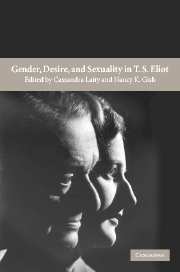Book contents
- Frontmatter
- Contents
- Acknowledgments
- Notes on contributors
- Introduction: Eliot, gender, and modernity
- Part I HOMOEROTICISMS
- Part II DESIRE
- Part III MODERN WOMEN
- Chapter 8 Through schoolhouse windows: women, the academy, and T. S. Eliot
- Chapter 9 T. S. Eliot speaks the body: the privileging of female discourse in Murder in the Cathedral and The Cocktail Party
- Chapter 10 T. S. Eliot, women, and democracy
- Chapter 11 Vipers, viragos, and spiritual rebels: women in T. S. Eliot's Christian society plays
- Index
Chapter 10 - T. S. Eliot, women, and democracy
Published online by Cambridge University Press: 22 September 2009
- Frontmatter
- Contents
- Acknowledgments
- Notes on contributors
- Introduction: Eliot, gender, and modernity
- Part I HOMOEROTICISMS
- Part II DESIRE
- Part III MODERN WOMEN
- Chapter 8 Through schoolhouse windows: women, the academy, and T. S. Eliot
- Chapter 9 T. S. Eliot speaks the body: the privileging of female discourse in Murder in the Cathedral and The Cocktail Party
- Chapter 10 T. S. Eliot, women, and democracy
- Chapter 11 Vipers, viragos, and spiritual rebels: women in T. S. Eliot's Christian society plays
- Index
Summary
This chapter explores two points of literary departure. First there are women, whose voices echo vacuously through domestic interiors and whose bodies straddle men and give promise “of pneumatic bliss,” women who consolidate ideas of male subjectivity in modernist writing. Second there is the debate between a politicized romanticism, which “made the revolution” and is linked to ideas of liberty, humanism, progress, democracy, and liberalism, and the new classicism in the arts, characterized alternatively by a reactionary politics of authority and discipline. Although both departures are crucial for Anglo-American modernist writing and for Eliot's work, they have only rarely been brought into dialogue with each other. However, Eliot's depiction of women as a shifting vehicle for his evolving political critique, initially of an individualistic liberal humanism, and later of mass democracy, recurs throughout his poetry and criticism.
A number of important discussions have addressed Eliot's poetic representation of women, including Albert Gelpi's detailed analysis of the way that “fear of women as the stimulants of an enslaving, defiling sexual passion is obsessive” in Eliot's early poems, Carol Christ's discussion of gender and voice in his early poems, and Lyndall Gordon's biographical analyses of Eliot's poems in relation to the women in his life. Michael Levenson, Jeffrey Perl, Michael North, and Kenneth Asher have discussed the importance of romanticism, classicism, liberalism, and democracy for modernist aesthetics.
- Type
- Chapter
- Information
- Gender, Desire, and Sexuality in T. S. Eliot , pp. 215 - 233Publisher: Cambridge University PressPrint publication year: 2004



